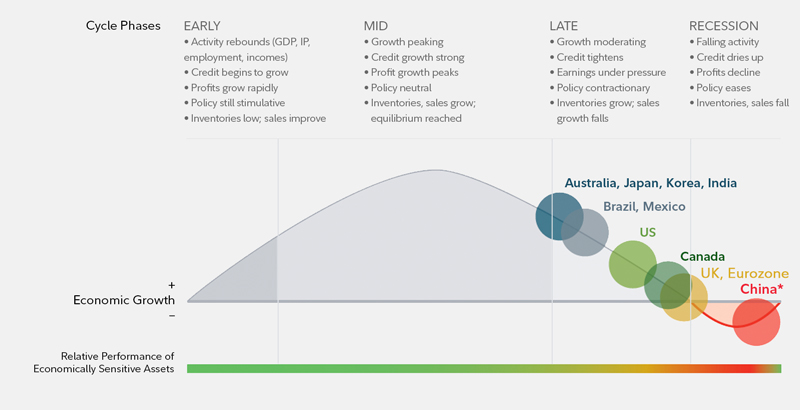At some point the market corrects for excesses?
America could theoretically minimize that exposure economic cycles with a controlled economy. That could, again, in theory- avoid contractions, recessions and depressions.
But near-term recession risk remains moderate.
- BY DIRK HOFSCHIRE, CFA, SVP; JACOB WEINSTEIN, CFA, RESEARCH ANALYST, ASSET ALLOCATION RESEARCH; LISA EMSBO-MATTINGLY, DIRECTOR; AND CAIT DOURNEY, ANALYST
- – 08/29/2022
- 3 MIN READ

Key takeaways
- The US is in the late-cycle expansion phase. The economy is still growing but the labor market is tight, companies are reporting less earnings, inventories are high, interest rates are rising, and the yield curve is flatter than it was earlier in the cycle.
- Globally, central banks have tightened monetary policy and major economies like China and Europe continue to be impacted by COVID and the Russian invasion of Ukraine. The chances of market volatility remain high as inflation persists amid slowing growth momentum and higher interest rates from the Federal Reserve.
United States
- The US is in the late-cycle expansion phase with moderate recession risk.
- The economy is exhibiting late-cycle trends including a tight labor market, declining profit margins, rising inventories, contractionary monetary policy, and a flatter yield curve.
- Nominal wage growth is the highest in decades, but high inflation has rendered real-wage growth negative and is weighing heavily on consumer confidence and real income expectations.
- Manufacturing supply-related pressures have started to ease, whereas housing and food inflation remain elevated, suggesting inflation will likely moderate but remain higher than levels experienced in recent decades.
- Federal Reserve (Fed) rate hikes have raised the cost of borrowing, especially for mortgage rates.
- Recent trends suggest a higher probability that the US may move through this cycle faster than prior cycles, but near-term recession risks remain moderate.
- Global manufacturing activity exhibited typical late-cycle patterns, including positive yet slowing growth rates, inflationary pressures, and rising inventories relative to sales.
- Europe is particularly exposed to fallout from the war in Ukraine, including higher natural gas prices, and these economies are experiencing high risk of recession.
- China is still struggling to emerge from its growth recession. COVID-related lockdowns have hamstrung the industrial recovery, but policy easing is picking up steam.
- Generally tighter global monetary policies and financial conditions are sapping momentum from the global expansion, and a broad set of crosswinds is creating greater differentiation among countries.
Asset allocation outlook
- The late-cycle phase may warrant smaller active allocation positions with a focus on diversified and disciplined investment strategies.
- The Fed faces a difficult balance of tightening monetary policy to confront decades-high inflation without prompting a downturn.
- Slower liquidity growth, persistent inflation risk, slowing growth momentum, and greater monetary policy uncertainty raise the odds that market volatility will remain elevated.
Business cycle framework
The business cycle, which is the pattern of cyclical fluctuations in an economy over a few years, can influence asset returns over an intermediate-term horizon. Cyclical allocation tilts are only one investment tool, and any adjustments should be considered within the context of long-term portfolio construction principles and strategic asset allocation positioning.

|